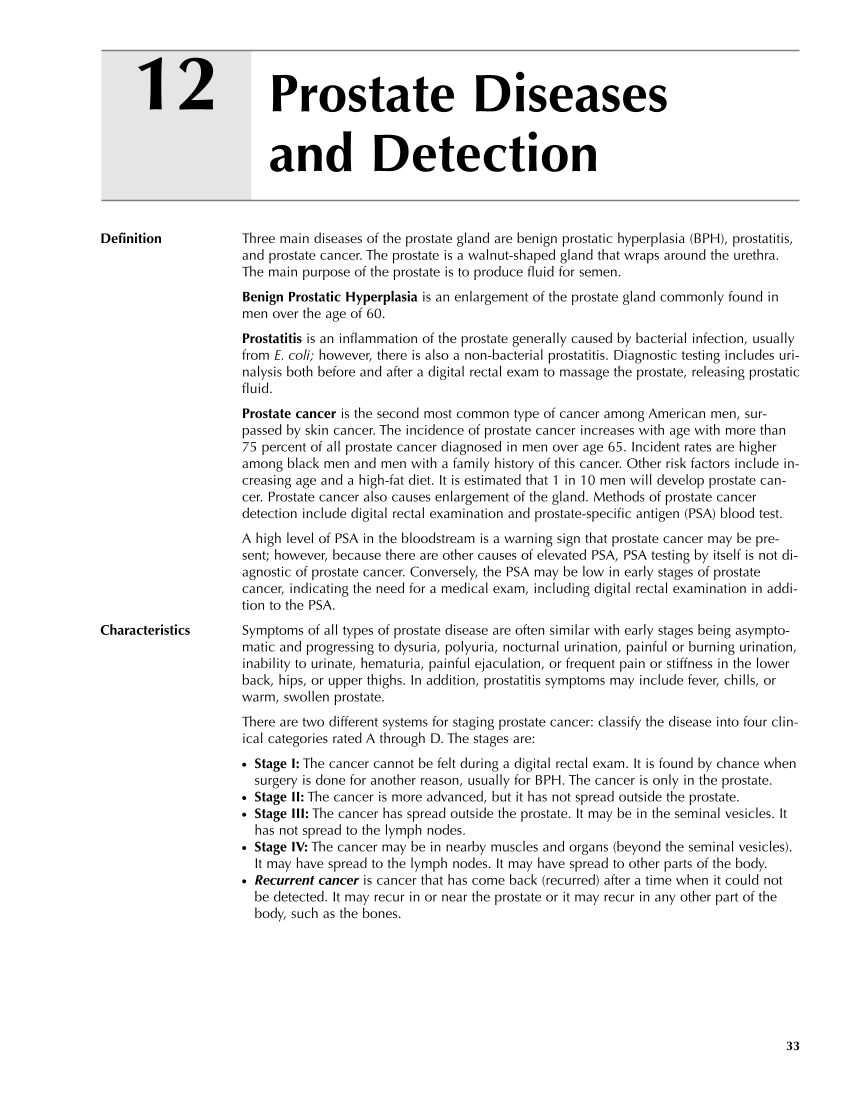33 Prostate Diseases and Detection 12 Definition Three main diseases of the prostate gland are benign prostatic hyperplasia (BPH), prostatitis, and prostate cancer. The prostate is a walnut-shaped gland that wraps around the urethra. The main purpose of the prostate is to produce fluid for semen. Benign Prostatic Hyperplasia is an enlargement of the prostate gland commonly found in men over the age of 60. Prostatitis is an inflammation of the prostate generally caused by bacterial infection, usually from E. coli however, there is also a non-bacterial prostatitis. Diagnostic testing includes uri- nalysis both before and after a digital rectal exam to massage the prostate, releasing prostatic fluid. Prostate cancer is the second most common type of cancer among American men, sur- passed by skin cancer. The incidence of prostate cancer increases with age with more than 75 percent of all prostate cancer diagnosed in men over age 65. Incident rates are higher among black men and men with a family history of this cancer. Other risk factors include in- creasing age and a high-fat diet. It is estimated that 1 in 10 men will develop prostate can- cer. Prostate cancer also causes enlargement of the gland. Methods of prostate cancer detection include digital rectal examination and prostate-specific antigen (PSA) blood test. A high level of PSA in the bloodstream is a warning sign that prostate cancer may be pre- sent however, because there are other causes of elevated PSA, PSA testing by itself is not di- agnostic of prostate cancer. Conversely, the PSA may be low in early stages of prostate cancer, indicating the need for a medical exam, including digital rectal examination in addi- tion to the PSA. Characteristics Symptoms of all types of prostate disease are often similar with early stages being asympto- matic and progressing to dysuria, polyuria, nocturnal urination, painful or burning urination, inability to urinate, hematuria, painful ejaculation, or frequent pain or stiffness in the lower back, hips, or upper thighs. In addition, prostatitis symptoms may include fever, chills, or warm, swollen prostate. There are two different systems for staging prostate cancer: classify the disease into four clin- ical categories rated A through D. The stages are: ● Stage I: The cancer cannot be felt during a digital rectal exam. It is found by chance when surgery is done for another reason, usually for BPH. The cancer is only in the prostate. ● Stage II: The cancer is more advanced, but it has not spread outside the prostate. ● Stage III: The cancer has spread outside the prostate. It may be in the seminal vesicles. It has not spread to the lymph nodes. ● Stage IV: The cancer may be in nearby muscles and organs (beyond the seminal vesicles). It may have spread to the lymph nodes. It may have spread to other parts of the body. ● Recurrent cancer is cancer that has come back (recurred) after a time when it could not be detected. It may recur in or near the prostate or it may recur in any other part of the body, such as the bones.
Purchased from OEM Press by (ge corporate access). (C) 2013 OEM Health Information, Inc. All rights reserved.












































































































































































































































































































































































































































